[ad_1]

A screen shot from Cory Arcangel’s “EDM Tutorials” Channel.
Certain popular social networks have origin stories that, from the outside, can feel a bit like techno-libertarian fantasies or misanthropic nerd-boy schemes. In contrast, the beginnings of the visual-based social network Are.na, which has become popular with artists like Cory Arcangel, Nick DeMarco, and Margaret Lee, stem out of a continuum of platforms and communities that have connected an internet art culture for well over a decade. And at a moment when many are publicly quitting other services, Are.na is growing. The team running Are.na recently shifted to a user-owned model for the site via the tech investment website Republic, where, at the time of writing, they have currently raised $145,568—291 percent of its minimum goal. I recently spoke to some of Are.na’s founders, as well as a few artists who regularly use it, to gain some insight into the rising platform.
Are.na, which first and foremost is a system for organizing and sharing ideas visually, was created in 2011 by Charles Broskoski, Damon Zucconi, Dena Yago, and John Michael Boling alongside J. Stuart Moore, an entrepreneur and co-founder of the digital consulting firm Sapient who provided funding. After Moore’s departure around a year and a half into the project, Broskoski told me that “instead of shutting everything down, because we were so passionate about working on it, he had decided to let us take the company and run with it.”
Over time, the platform’s core audience started to slowly pick up steam to the point where Zucconi and Broskoski—by winter 2014, the two remaining creators—went part-time at their day jobs. The network became available to the public in July 2015. Roughly around this same period, Zucconi and Broskoski came in contact with Christopher Barley, who runs a strategy and consulting company in New York called Consortia. Broskoski told me that Barley was interested in the idea of “how do we market intelligence as a cool thing,” and he provided funding for the platform last May. Since then, the user jump has risen from around 8,000 to roughly 42,000, and both Zucconi and Broskoski, alongside three others, now work full-time.
Are.na is based around a series of “channels” of visual information created by users and organized into smaller blocks of content. Channels can be private, closed (anyone can see it, but only the user can add to it), or open, which means users on Are.na can add a block to the channel, with the creator reserving the right to cull and modify information. The main social component of the platform involves users making “connections” between channels, or taking existing information on the network and connecting that block to another channel. “It’s a harder thing to do,” Broskoski noted. “A connection is a little more conceptually difficult than something like a ‘like,’ because you have to think of something in two different contexts at the same time. You’re like, Oh that fits [here], but it also fits there.”
With that said, it is worth mentioning that there is no way to officially “like” any of the content posted on Are.na. “In the beginning, we very much had to force ourselves to be, like, Ok, we’re not gonna put ‘liking’ things in it,” Zucconi told me over the phone. “I think that’s something that’s absolutely irresistible to most other people building similar platforms, which I kind of find hilarious.” There are also no advertisements. The platform’s social component mostly takes a backseat to what Broskoski referred to as a “fuzzier type of thinking” that encourages a more broad-minded and conceptual approach to how we process and arrange the never-ending stream of information we encounter on the internet. Naturally, the website is popular with internet artists, academics, and designers of all stripes.
Conceptually, Are.na is informed less by Facebook or Twitter and more by the niche link sharing website del.ic.ous, which had its heyday in the early 2000s as a hub for internet artists, led partly by the influential artist Cory Arcangel (Broskoski noted that when Arcangel was his professor at Parsons, he made all of his students use the service and share links in class). Del.ic.ous could also be seen as a predecessor to the net art-driven “surf clubs” that popped up in its wake, and as part of a longer chain of artist-driven sharing on the internet. “The thing that was cool about del.ic.ous was that we had sort of worked in single-player mode first and foremost,” Broskoski said. “And then the social part of it was sort of the secondary part, so you were just doing your thing, assembling your own research and then later on you could find other people whose perspectives overlapped with yours.”
Arcangel, speaking to me over the internet from his home in Norway, agreed. “I used to love del.ic.ous,” he said. “And [Are.na] reminds me a lot of del.ic.ous, the way that connections are made.” The artist Nick DeMarco, who is the creator of the popular Are.na channel “Yuppie Dystopia,” uses the service to make those kinds of abstract connections. DeMarco said that when he is “just cruising on the impersonal internet—you know, the current, like, Facebook, Twitter, you’re barely on the open ocean of the internet anymore, it’s almost always filtered through one of those things . . . when you see the cracks form or some x-factor image that feels like its a weird thing that you’re seeing, it’s cool to have a place to put it”—which is to say, on the Yuppie Dystopia channel.
There are many ways to use the network. Arcangel told me that he is a future investor in the company and that he uses Are.na, and especially its mobile app, for a variety of tasks, from the professional (“I have lists and titles for shows, I have a list of artists that I like, I have all these lists”) to the personal (“If I’m bored at night, I would probably go on Are.na and click around”). He sees it, perhaps most importantly, as a network that “doesn’t bother you and it’s not annoying, and it doesn’t make you depressed.” He continued, “It doesn’t produce anxiety, that’s a better way to put it.” In this era, that is perhaps the highest compliment any social media network could receive.
[ad_2]
Source link

